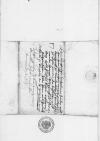List #5217
Ioannes DANTISCUS do Albrecht I von Hohenzollern-AnsbachHeilsberg (Lidzbark Warmiński), 1539-07-17
| odebrano Königsberg, 1539-07-18 Rękopiśmienne podstawy źródłowe:
Pomocnicze podstawy źródłowe:
Publikacje:
| ||||||||||
Tekst + aparat krytyczny + komentarzZwykły tekstTekst + komentarzTekst + aparat krytyczny
 GStA, PK, HBA, C 1, No 579, f. 3v
GStA, PK, HBA, C 1, No 579, f. 3v
Dem durchlauchten, hochgebornen fursten und hern, hern
 GStA, PK, HBA, C 1, No 579, f. 1r
GStA, PK, HBA, C 1, No 579, f. 1r
Durchlauchter, hochgeborner furst, hochgunstiger, lyber her und freundt. / Unser freuntliche, wÿllige dinst zuvoran. /
Wir haben negst E(wer) F(urstlichen) D(urchlauch)t den IIII dyts monts was zu beantwurten der selbten negsth cf.
Datum(m)

